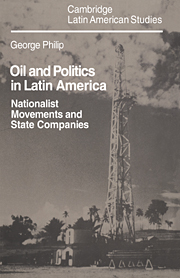Book contents
- Frontmatter
- Contents
- List of tables
- Preface
- Glossary
- Abbreviations
- Note on currencies and other units of measurement
- Maps: Latin America in 1920, 1940, 1960 and 1981; showing importing countries, exporting countries and countries self-sufficient in oil
- Introduction: The politics of oil in twentieth-century Latin America
- Part I The world oil environment
- Part II The major expropriations
- 7 Politics and the concession contract
- 8 Argentina: YPF, Yrigoyen and the 1935 oil law
- 9 Some nationalisations of the 1930s: Chile, Uruguay, Bolivia
- 10 Cárdenas and the Mexican oil nationalisation
- 11 The formation of Petrobrás
- 12 The nationalisation of the ipc in Peru
- 13 The nationalisation of Gulf Oil in Bolivia 1969
- 14 Oil politics in Ecuador 1972–6
- 15 The nationalisation of oil in Venezuela
- 16 Oil companies and governments in twentieth-century Latin America
- Part III The state oil companies
- Notes and bibliography
- Index
- CAMBRIDGE LATIN AMERICAN STUDIES
12 - The nationalisation of the ipc in Peru
Published online by Cambridge University Press: 23 December 2009
- Frontmatter
- Contents
- List of tables
- Preface
- Glossary
- Abbreviations
- Note on currencies and other units of measurement
- Maps: Latin America in 1920, 1940, 1960 and 1981; showing importing countries, exporting countries and countries self-sufficient in oil
- Introduction: The politics of oil in twentieth-century Latin America
- Part I The world oil environment
- Part II The major expropriations
- 7 Politics and the concession contract
- 8 Argentina: YPF, Yrigoyen and the 1935 oil law
- 9 Some nationalisations of the 1930s: Chile, Uruguay, Bolivia
- 10 Cárdenas and the Mexican oil nationalisation
- 11 The formation of Petrobrás
- 12 The nationalisation of the ipc in Peru
- 13 The nationalisation of Gulf Oil in Bolivia 1969
- 14 Oil politics in Ecuador 1972–6
- 15 The nationalisation of oil in Venezuela
- 16 Oil companies and governments in twentieth-century Latin America
- Part III The state oil companies
- Notes and bibliography
- Index
- CAMBRIDGE LATIN AMERICAN STUDIES
Summary
The history of the International Petroleum Company in Peru was so varied and dramatic that it provided at one time or another a case study of nearly every conceivable permutation of host government – oil company relations. Essentially, the IPC took over a dubious legal title in 1913, used force and bribery to establish itself in the country and earned fabulous profits in the 1920s and 1930s. Subsequently its fortunes changed and IPC spent nearly a decade under economic pressure and political attack before its final expropriation in 1968. The expropriation was dramatic and the refusal of compensation led to serious conflict between Peru and the USA which, as we have seen, ended in 1973 with a compromise agreement which gave IPC only a fraction of the market value of its holdings.
The IPC in Peru: from exporter to supplier of the domestic market
The periods before and after about 1952 were very distinct. In the first period IPC, as an exporting company, was able to buy political support and retain extremely high profits for itself. Between 1913 and 1922 it was able to establish for itself an exceptionally favourable long-term position in Peru by its willingness to offer ready cash to governments with immediate financial problems. The pattern of offering short-term loans in return for favours was established early and continued until late. In 1938 the British Minister remarked that ‘the demand for a loan from this company is nothing new. Indeed, the International and the Cerro de Pasco Copper Corporation have for years been the cows supplying milk for the government's necessitous children.’
- Type
- Chapter
- Information
- Oil and Politics in Latin AmericaNationalist Movements and State Companies, pp. 243 - 257Publisher: Cambridge University PressPrint publication year: 1982



